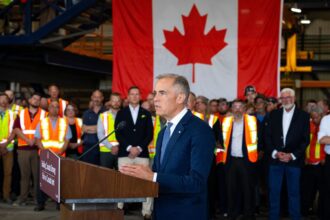In a decisive move to bolster one of Canada’s cornerstone industries, Prime Minister Mark Carney announced a comprehensive support package for the softwood lumber sector yesterday in Vancouver. The announcement comes after months of escalating trade tensions and economic pressure that have left many Canadian lumber producers struggling to maintain operations in an increasingly competitive global market.
“Today, we’re taking concrete action to protect Canadian jobs and strengthen our forest communities,” declared Carney, speaking to a gathering of industry representatives and union leaders. “This $500 million support package represents our commitment to ensuring this vital sector can weather current challenges while positioning itself for future growth.”
The softwood lumber industry, which employs over 200,000 Canadians and contributes approximately $25 billion annually to our economy, has faced significant headwinds in recent years. Persistent U.S. tariffs, averaging 17.9% since 2017, have eroded profit margins and threatened the viability of operations in several provinces. British Columbia has been particularly hard-hit, with more than a dozen mill closures in the past three years.
The newly announced measures include $250 million in direct financial assistance to affected companies, $150 million for worker retraining programs, and $100 million earmarked for technological innovation initiatives aimed at improving efficiency and exploring new market opportunities beyond the United States.
Industry reaction has been cautiously optimistic. Susan Richardson, CEO of the Canadian Lumber Manufacturers Association, called the package “a necessary first step” but emphasized that “long-term stability will ultimately depend on achieving a fair trade agreement with our American partners.”
Forest industry unions have expressed similar sentiments. “These supports will help keep our members employed in the short term,” noted James Wilson of the United Forestry Workers. “However, we need sustainable solutions that address the fundamental trade inequities that have plagued this sector for decades.”
The announcement follows similar support packages implemented by previous governments, though analysts note that Carney’s approach places greater emphasis on modernization and diversification. Dr. Elizabeth Chen, an economist at the University of British Columbia specializing in resource industries, points out that “the focus on technological innovation represents an important shift in strategy—acknowledging that Canadian lumber producers must evolve to remain competitive globally.”
Provincial leaders have welcomed the federal initiative, with British Columbia Premier David Eby describing it as “vital support for communities that have been devastated by mill closures.” Quebec’s François Legault similarly praised the package while urging federal officials to continue pressing for a permanent resolution to the longstanding trade dispute.
Critics, however, question whether the measures go far enough. Opposition leaders have suggested that the package merely offers temporary relief without addressing the systemic challenges facing the industry. “We’re putting bandages on a patient that needs surgery,” remarked Conservative industry critic James Morrison.
Environmental groups have also weighed in, with several organizations calling for sustainability requirements to be attached to the financial assistance. “Any support for the forestry sector must be conditional on improved harvesting practices and habitat protection,” stated Jennifer Adams of the Canadian Environmental Network.
As Canada’s softwood lumber producers navigate these turbulent waters, the question remains: can this support package successfully bridge the gap until a more permanent trade solution is found, or are we merely postponing an inevitable reckoning for an industry caught between changing markets and persistent trade barriers?










